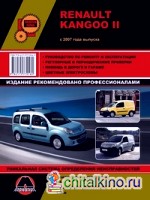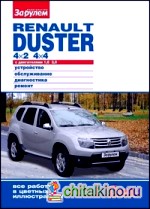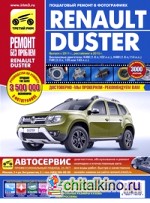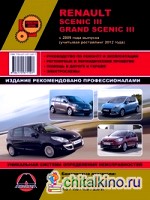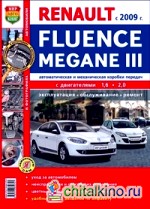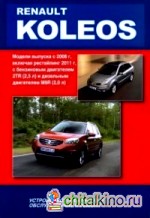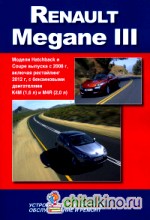Занялся давеча вопросом почитать про работу всех ассистентов в машине и прочее. Нашёл ссылку на драйве на мануал на американском сайте, но ссылка оказалось битой. В итоге, порыскал по сети и накачал доков. Все залил в контейнер на Google Drive. Текущим и будущим владельцам может быть полезно. Контейнер буду обновлять по мере нахождения. Если у кого-то что-то есть — скидывайте, добавлю.
На текущий момент на диске представлены:
— Renault Talisman 2015 Owner’s Manual (Eng);
— Renault Talisman 2016 Owner’s Manual (Eng);
— Renault Talisman 2017 Owner’s Manual (Eng);
— Renault Talisman 2018 Owner’s Manual (Eng);
— Renault Talisman Owner’s Manual (Eng);
— Renault Talisman 2016 Lifecycle Assessment results (Eng);
— R Link 2 Manual (Rus).
drive.google.com/drive/fo…wPxApB0ETp3aX1zPKp6UsphL9
Пробег: 140 000 км
- Manuals
- Brands
- Renault Manuals
- Automobile
- Talisman
- Driver’s handbook manual
-
Contents
-
Table of Contents
-
Bookmarks
Related Manuals for Renault Talisman
Summary of Contents for Renault Talisman
-
Page 1
TALISMAN DRIVER’S HANDBOOK renaultusa.com… -
Page 2
Renault cars. Lasting protection and optimum performance for your engine – guaranteed. Whether changing the oil or simply topping up, to find the approved ELF lubricant best suited to your vehicle, ask your Renault dealer for a recommendation or consult your vehi- cle maintenance handbook. -
Page 3: Driving
This handbook may also contain information about items of equipment to be introduced later in the model year. Throughout the manual, the “approved Dealer” is your RENAULT Dealer. Enjoy driving your new vehicle.
-
Page 5: Table Of Contents
Sections Getting to know your vehicle ……. Driving …………..Your comfort …………Maintenance …………Practical advice ………… Technical specifications ……..Alphabetical index ……….
-
Page 7
RENAULT card: general information, use …….. -
Page 8: Remote Control Key: General Information, Use
REMOTE CONTROL KEY: general information (1/2) Driver’s responsibility 1 Locks all the opening elements. Never leave an animal, child or adult who is not 2 Unlocks all the opening elements. self-sufficient alone in your 3 Ignition and front door key. vehicle, even for a short time.
-
Page 9
REMOTE CONTROL KEY: general information (2/2) Radio frequency remote control operating range This varies according to the surround- ings: take care not to lock or unlock the doors by inadvertently pressing the but- Replacement and additional tons on the remote control. remote controls. -
Page 10: Locking The Doors
REMOTE CONTROL KEY: use Note: The remote control A can be used to lock or unlock the doors and boot. With the engine running, the ignition It is powered by a battery which must switched on and in accessories position be replaced (refer to the information on (refer to “Ignition switch: vehicles with a “Radio frequency remote control: bat-…
-
Page 11: Renault Card: General Information, Use
“Keycard battery low” appears on the instrument panel (refer to the informa- When the battery is flat, you can tion on the “RENAULT card: battery” in still lock/unlock and start your vehi- section 5). cle. Please see the information on “Locking and unlocking the doors”…
-
Page 12
(2/2) Advice Avoid leaving the card in hot, cold or humid areas. Do not keep the RENAULT card in a place where it could be bent or damaged accidentally, such as in a Driver’s responsibility back pocket of a garment. -
Page 13
In “hands-free” mode, it is possible to activating equipment such as the lock/unlock the vehicle without using electric windows or locking the any of the RENAULT card’s buttons, doors, for example. as long as the card is within the access Also, in hot and/or sunny weather, zone 1. -
Page 14
“Hands-free” locking the sensor 3, there is a delay of approx- imately 3 seconds before it can be un- With the RENAULT card in zone 1, With the RENAULT card on you, and locked again. During these 3 seconds, place your hand on a door handle 2: the… -
Page 15
Note: The maximum distance at which system (continued) the vehicle locks depends on the sur- control roundings. If the RENAULT card has been within Unlocking with the card RENAULT range for approximately 15 minutes, Special features Press the button 5. -
Page 16
RENAULT CARD: usage (4/4) Driver’s responsibility Never leave an animal, child or adult who is not self-sufficient alone in your vehicle, even for a short time. They may pose a risk to themselves If, while the engine is running, a door… -
Page 17
If the remote control or the RENAULT card does not work: In certain cases, the radio frequency remote control or the RENAULT card may not work: – RENAULT card/radio frequency remote control battery worn or run flat, vehicle battery flat, etc. -
Page 18
Slide the back 4 of the casing down- Once you are inside the vehicle, put the wards, while pressing down on the front key back in its casing in the RENAULT side at the top 4. card. 1.12… -
Page 19
Unlocking the vehicle from the outside When you lock the doors from the out- is only possible with the RENAULT card side, the indicator light remains lit for a in the vehicle’s access zone or using moment, and then goes out. -
Page 20: Opening And Closing The Doors
Opening the doors from the Opening from the inside outside Pull on the handle 2. With the doors unlocked or RENAULT card on you, hold handle 1 and pull it towards you. As a safety precaution, the doors should only be opened or closed when the vehicle is stationary.
-
Page 21
OPENING AND CLOSING THE DOORS (2/2) Once the vehicle reaches a speed of Driver’s responsibility approximately 20 km/h (12 mph), a when parking or stopping warning light indicates the opening the vehicle element(s) (door, boot) open of im- properly closed, alongside the mes- Never leave an animal, sage “Boot open”… -
Page 22: Automatic Locking When Driving
AUTOMATIC LOCKING WHEN DRIVING Activating/deactivating the Operating faults function If you experience an operating fault (no To switch it on: with the vehicle at a automatic locking, the indicator light in- standstill and the engine running, press corporated in switch 2 does not light up switch 2 until a beep sounds.
-
Page 23: Automatic Trunk Lid
There are four modes to manoeuvre ing the trunk lid from opening, this ice the trunk lid: or snow must be removed to free the – using the RENAULT card remote trunk lid. control; – In the event that the battery is dis- –…
-
Page 24
Press control 2. control full. With the RENAULT card on your person With the ignition off, press and hold and with the ignition off, perform a for- switch 1 on the RENAULT card. -
Page 25
15 minutes if the vehicle is ture inside the passenger compart- unlocked. To reactivate it, use the ment increases very quickly. unlocking button on the RENAULT RISK OF DEATH OR SERIOUS card. INJURY. – the hands-free function is only avail-… -
Page 26: Clock And Exterior Temperature
CLOCK AND EXTERIOR TEMPERATURE External temperature indicator Special note: When the exterior temperature is — 3 °C to + 3 °C, the °C characters flash (sig- nalling a risk of ice on the road). Display 1 Vehicles fitted with a touchscreen multimedia screen, navigation aid systems, etc.
-
Page 27: Front Headrests
FRONT HEADRESTS To adjust side supports B Depending on the vehicle, sections B can be adjusted independently to the desired position. To remove the headrest Raise it to its highest position (tilt the seatback backwards if necessary). Press button 2 and lift the headrest to release it.
-
Page 28
FRONT SEATS WITH MANUAL CONTROL (1/2) To tilt the seatback Lift handle 3 and tilt the seatback to the desired position. Release the handle at the desired position and make sure that it is locked. To move the seat forwards or To adjust the seat’s lumbar backwards position… -
Page 29
FRONT SEATS WITH MANUAL CONTROL (2/2) Heated seats With the ignition on, press the switch 5 for the seat desired. The indicator light For safety reasons, make in the switch lights up. these adjustments only The system automatically decides when the vehicle is station- whether or not the heating is needed. -
Page 30: Adjusting The Seat Position
FRONT SEATS WITH ELECTRIC CONTROLS (1/2) Adjusting the seat position To move the seat forwards or back- wards Move switch 4 forwards or backwards. To raise or lower the seat base Move the back of switch 4 up or down. To tilt the seat base (depending on the vehicle) Move the front of switch 4 up or down.
-
Page 31: Ventilated Seats
FRONT SEATS WITH ELECTRIC CONTROLS (2/2) Press the switch 7 to activate the wind in the seat cushion and seat back vents. Ventilation seats consist of the princi- ple, in which they absorb and export the inside air without the air-condition- ing and heating functions.
-
Page 32
FRONT SEATS: Functions (1/3) Browse menu “Driver” or “Passenger” Massage Driver Passenger – select the type of massage (Tonic, Massage Relaxing or Lumbar); – adjust the intensity (+ or -); – adjust the speed (+ or -); Tonic Relaxing Lumbar –… -
Page 33
FRONT SEATS: Functions (2/3) Easy driver and passenger access Press “ON” or “OFF” to activate or de- Easy access driver activate this function. Easy access passenger When this function is activated, the seat automatically moves back when Courtesy for passenger the driver or passenger leaves the vehi- cle, and returns to its position when the Position… -
Page 34
The storage and recall of the driving and front passenger position is possi- Save ble by pressing the buttons: – RENAULT hands-free card detected; Simultaneous saving of the driving Simultaneous recall of the saved – when the driver’s door is opened. -
Page 35: Seat Belts
SEAT BELTS (1/3) Always wear your seat belt when trav- Before starting, first adjust your driv- elling in your vehicle. You must also ing position, then ask all occupants comply with the legislation of the par- to adjust their seat belts to ensure ticular country you are in.
-
Page 36
SEAT BELTS (2/3) Driver’s seat belt reminder ß and, depending on the vehi- cle, front passenger seat belt re- minder This lights up on the interior rear-view mirror when starting the engine then, if the driver’s or front passenger’s seat belt (if this seat is occupied) is not fas- tened and the vehicle has reached approximately 20 km/h (12 mph), it… -
Page 37: Front Seat Belts
SEAT BELTS (3/3) – No modification may be made to the component parts of the originally fitted restraint system: belts, seats and their mountings. For special op- erations (e.g. fitting child seats) contact an authorised dealer. – Do not use devices which allow any slack in the belts (e.g. clothes pegs, clips, etc.): a seat belt which is worn too loosely may cause injury in the event of an accident.
-
Page 38: Rear Seat Belts
REAR SEAT BELTS Before each folding operation of the rear seats, the lateral seatbelt cor- responding to the seat itself must be locked in this own buckle. This precaution of use will avoid the blocking of safety belts whereas the seat returns to the position of use.
-
Page 39
METHODS OF RESTRAINT IN ADDITION TO THE FRONT SEAT BELTS (1/4) Depending on the vehicle, they are – Have the entire restraint composed of: system checked following – seat belt inertia reel pretension- an accident. ers; – No operation whatso- –… -
Page 40: Methods Of Restraint In Addition To The Front Seat Belts
METHODS OF RESTRAINT IN ADDITION TO THE FRONT SEAT BELTS (2/4) Load limiter Air bags for driver and front passenger Above a certain severity of impact, this mechanism is used to limit the force of Fitted to the driver and passenger side. the belt against the body so that it is at The presence of this equipment is in- an acceptable level.
-
Page 41
METHODS OF RESTRAINT IN ADDITION TO THE FRONT SEAT BELTS (3/4) Operation Special feature of the front air This system is only operational when the ignition is switched on. After a violent impact, it has two deploy- ment volumes and integrates a ventila- In a severe frontal impact, the air bags tion system: inflate rapidly, cushioning the impact… -
Page 42
METHODS OF RESTRAINT IN ADDITION TO THE FRONT SEAT BELTS (4/4) All of the warnings below are given so that the air bag is not obstructed in any way when it is inflated and also to prevent the risk of serious injuries caused by items which may be dislodged when the air bag inflates. Warnings concerning the driver’s air bag –… -
Page 43
METHODS OF RESTRAINT IN ADDITION TO THE REAR SEAT BELTS Force limiter Above a certain severity of impact, this mechanism is used to limit the force of the belt against the body so that it is at an acceptable level. –… -
Page 44
SIDE PROTECTION DEVICES Side air bags These air bags are fitted to the front seats and are activated at the sides of the seats (door side) to protect the oc- cupants in the event of a severe side impact. Curtain air bags These are air bags fitted along the sides of the vehicle in the ceiling which trigger along the front and rear side windows… -
Page 45: Additional Methods Of Restraint
ADDITIONAL METHODS OF RESTRAINT Operating faults All of the warnings below are given so that the air bag is not obstructed in any way when it is inflated and also to prevent the risk of serious injuries caused å by items which may be dislodged when the air bag inflates. This warning light comes on when the engine is started and then The air bag is designed to complement the action of the seat belt.
-
Page 46: Child Safety: General Information
CHILD SAFETY: General information (1/2) Carrying children Children, and adults, must be correctly seated and strapped in for all journeys. The children being carried in your vehi- cle are your responsibility. A child is not a miniature adult. Children are at risk of specific injuries as their muscles and bones have not yet fin- Driver’s responsibility ished growing.
-
Page 47
CHILD SAFETY: General information (2/2) Using a child seat The level of protection offered by the child seat depends on its ability to re- strain your child and on its installation. Incorrect installation compromises the protection it offers the child in the event of harsh braking or an impact. -
Page 48
CHILD SAFETY: choosing a child seat Rear-facing child seats Forward-facing child seats Booster cushions A baby’s head is, proportionally, heavier The child’s head and abdomen need to From 15 kg or 4 years, the child can than that of an adult and its neck is very be protected as a priority. -
Page 49: Choosing A Child Seat Mounting
CHILD SAFETY: choosing a child seat mounting (1/2) There are two ways of attaching child Attachment using the ISOFIX Before using an ISOFIX seats: via the seat belt or using the system child seat that you pur- ISOFIX system. Approved child seats ISOFIX are stand- chased for another vehicle, ardised in accordance with current reg- check that its installation is…
-
Page 50
CHILD SAFETY: choosing a child seat mounting (2/2) The four rings 1 are located between In all cases, attach the strap hook to the the seatback and the seat base of the corresponding ring 2. seat and are identified by a marking. Pull the belt so that the back of the child The third ring is used to attach the seat comes into contact with the back… -
Page 51: Fitting A Child Seat, General Information
CHILD SAFETY: fitting a child seat, general information (1/2) Some seats are not suitable for fitting The types of child seat indicated may After installing the child seat, if neces- child seats. The diagram on the follow- not be available. Before using a differ- sary, the seat may be advanced (so as ing page shows you how to attach a ent child seat, check with the manufac-…
-
Page 52
CHILD SAFETY: fitting a child seat, general information (2/2) In the rear seat A carrycot can be installed across the vehicle and will take up at least two seats. Position the child with his or her feet nearest the door. Move the front seat as far forward as possible to install a rear-facing child seat, then move back the seat in front… -
Page 53
CHILD SEATS: attachment by seat belt (1/3) ³ Check the status of the airbag before fitting a child seat or allowing a passenger to use the seat. Seat not suitable for fitting ² child seats. Child seat attached using the belt ¬… -
Page 54
CHILD SEATS: attachment by seat belt (2/3) The table below summarises the information already shown in the diagram on the previous pages, to ensure the appli- cable regulations are respected. Five-seater version Front passenger Type of child seat Weight of the child Rear side seats Rear centre seat seat (1) -
Page 55
CHILD SEATS: attachment by seat belt (3/3) X = Seat not suitable for fitting child seats of this type. U = Seat which allows a child seat with “Universal” approval to be installed using a seat belt; check that it can be fitted. (2) A carrycot can be installed across the vehicle and will take up at least two seats. -
Page 56
CHILD SEATS: attachment using the ISOFIX system (1/3) The table below summarises the information already shown in the diagram on the following pages, to ensure the regula- tions in force are respected. Five-seater version Weight of Front passenger Type of child seat Seat size ISOFIX Rear side seats (4) Rear centre seat… -
Page 57
CHILD SEATS: attachment using the ISOFIX system (2/3) X = Seat not suitable for fitting child seats ISOFIX. IUF/IL = On equipped vehicles, seat which allows an approved “Universal/semi-universal” or “vehicle specific” child seat to be at- tached using the ISOFIX system; check that it can be fitted. i-U = Suitable for the i-Size restraint devices in the “universal”… -
Page 58
CHILD SEATS: attachment using the ISOFIX system (3/3) Child seat fitted using the ISOFIX mounting Seat which allows an ISOFIX child seat to be attached. ± The rear seats are fitted with an anchorage point which allows a forward-facing ISOFIX child seat with universal approval to be attached. -
Page 59
CHILD SAFETY: deactivating, activating the front passenger air bag (1/3) The passenger air bag must only be deactivated or acti- vated with the ignition off. If it is interfered with when the vehicle is being driven, indicator å © lights will come Switch the ignition off then on again to reset the air bag in accordance… -
Page 60
CHILD SAFETY: deactivating, activating the front passenger air bag (2/3) The markings on the dashboard and labels A on each side of the passen- ger sun visor 3 (example: label shown above) remind you of these instruc- tions. DANGER Since operation of the front passenger air bag is not compatible with the position of a rear-facing child seat, NEVER… -
Page 61
CHILD SAFETY: deactivating, activating the front passenger air bag (3/3) Operating faults It is forbidden to fit a rear-facing child seat to the front passenger seat if the airbags activation/deactivation system is faulty. Allowing any other passenger to sit in that seat is not recommended. -
Page 62: Driving Position
DRIVING POSITION (1/2) 13 14 1.56…
-
Page 63: Instrument Panel
5 Instrument panel. 14 Heating or air conditioning con- trols. 24 Engine start/stop button (vehicle 6 Head-up display. with RENAULT card). 15 Passenger Airbag location. 7 Controls for: 25 Ignition switch (vehicles with key). – on-board computer information 16 Glovebox.
-
Page 64
WARNING LIGHTS (1/6) The display of information shown below DEPENDS ON THE VEHICLE EQUIPMENT AND COUNTRY. Side light warning light Left-hand direction indicator š tell-tale Main beam headlight tell- Right-hand direction indica- á tale tor tell-tale Dipped beam headlight tell- Low fuel level warning light tale It lights up orange when the ig-… -
Page 65
WARNING LIGHTS (2/6) The display of information shown below DEPENDS ON THE VEHICLE EQUIPMENT AND COUNTRY. Brake circuit fault warning Oil pressure warning light À light It lights up when the ignition or It lights up when the ignition or the the engine is switched on and goes off engine is switched on and goes off after after a few seconds. -
Page 66
WARNING LIGHTS (3/6) The display of information shown below DEPENDS ON THE VEHICLE EQUIPMENT AND COUNTRY. Toxic Fume Filter System Anti-lock braking warning Ä Warning Light light It lights up when the ignition or the For vehicles equipped with this option, engine is switched on and goes off after the light comes on when the ignition is a few seconds. -
Page 67
WARNING LIGHTS (4/6) The display of information shown below DEPENDS ON THE VEHICLE EQUIPMENT AND COUNTRY. Rear seat belt reminder (depending Air bag warning light å on vehicle) This warning light will be dis- played on the instrument panel when ß… -
Page 68
WARNING LIGHTS (5/6) The display of information shown below DEPENDS ON THE VEHICLE EQUIPMENT AND COUNTRY. Speed limiter, Electronic parking brake Φ cruise control and fault light adaptive cruise control warning Please refer to the information on the lights “Electronic parking brake” in Section 2. Please refer to the information on the Emergency active brake “Speed limiter”, “Cruise control”… -
Page 69
WARNING LIGHTS (6/6) The display of information shown below DEPENDS ON THE VEHICLE EQUIPMENT AND COUNTRY. Driver’s seat belt reminder ß and, depending on the vehi- cle, front passenger seat belt re- minder. This lights up in the rear-view mirror when the ignition is started then, if the driver or front passenger seat belt (if this seat is occupied) is not fastened… -
Page 70
DISPLAYS AND INDICATORS (1/4) Speedometer 5 (km per hour) This is displayed differently according to how the instrument panel is custom- ised. Overspeed buzzer Depending on the vehicle and coun- try, a buzzer sounds for approximately 10 seconds every 40 seconds, as long as the vehicle is travelling in excess of 120 km/h (72 mph). -
Page 71: Coolant Temperature
DISPLAYS AND INDICATORS (2/4) Vehicles fitted with a navigation Coolant temperature Engine oil level low warning system indicator 6 When the engine is started, the instru- On the multifunction screen, select ment panel display A alerts you when “System” , “User profile” and “Unit”. the minimum oil level is reached.
-
Page 72: Displays And Indicators
DISPLAYS AND INDICATORS (3/4) You can adjust certain settings from the multifunction screen: with the engine running, access menu “System”, “Display” then “Head-up display”. Adjusting the display information height Depending on your driving position, you can raise or lower the information on the display.
-
Page 73
DISPLAYS AND INDICATORS (4/4) Operating faults In the event of a malfunction (the dis- play fails to open when the engine is started, or the display retracts, with the engine running, following an object im- pacting the display): – stop and restart the engine; –… -
Page 74: On-Board Computer 1
ON-BOARD COMPUTER: general information (1/2) Display selection keys 2 Scroll through the following information by repeated short presses on button 2 (the display depends on the vehicle equipment and country): a) total mileage and trip mileage re- corder; b) journey parameters: –…
-
Page 75
ON-BOARD COMPUTER: general information (2/2) Interpreting some of the values displayed after resetting The values showing average fuel con- sumption and average speed will become more stable and reliable the further you have travelled since the last time the Reset button was pressed. The average fuel consumption may de- crease when: –… -
Page 76
ON-BOARD COMPUTER: trip settings (1/5) The display of information shown below DEPENDS ON THE VEHICLE EQUIPMENT AND COUNTRY. Examples of selections Interpreting the display selected 101778 km 112.4 km a) Total mileage and trip mileage recorder. Fuel used b) Journey parameters. Fuel used. -
Page 77
ON-BOARD COMPUTER: trip settings (2/5) The display of information shown below DEPENDS ON THE VEHICLE EQUIPMENT AND COUNTRY. Examples of selections Interpreting the display selected Range Estimated range with remaining fuel. The value is displayed after driving 400 metres. 541 km Distance Distance travelled since the last reset. -
Page 78
ON-BOARD COMPUTER: trip settings (3/5) The display of information shown below DEPENDS ON THE VEHICLE EQUIPMENT AND COUNTRY. Examples of selections Interpreting the display selected On-board computer with mileage- before-service message c) Mileage before service or oil change. Mileage before service Service in With the ignition switched on, the engine not running and Service Intervals… -
Page 79
ON-BOARD COMPUTER: trip settings (4/5) The display of information shown below DEPENDS ON THE VEHICLE EQUIPMENT AND COUNTRY. Examples of selections Interpreting the display selected On-board computer with distance before next service message (cntd.) c) Mileage before service or oil change. Mileage before oil change Oil change in With the ignition switched on and the engine not running,… -
Page 80
ON-BOARD COMPUTER: trip settings (5/5) The display of information shown below DEPENDS ON THE VEHICLE EQUIPMENT AND COUNTRY. Examples of selections Interpreting the display selected d) Reset the tyre pressure. Please refer to the information on the “Tyre pressure Tyre pressure monitoring system”… -
Page 81
TRIP COMPUTER AND WARNING SYSTEM: information messages These can help in the vehicle starting phase, or give information about a selection or a driving status. Examples of information messages are given in the following pages. Examples of messages Interpreting the display selected «… -
Page 82
TRIP COMPUTER AND WARNING SYSTEM: operating fault messages © These appear with the warning light and mean that you should drive very carefully to an authorised dealer as soon as possible. If you fail to follow this recommendation, you risk damaging your vehicle. They disappear when the display selection key is pressed or after several seconds and are stored in the computer log. -
Page 83
TRIP COMPUTER AND WARNING SYSTEM: warning message ® These appear with the warning light and require you to stop immediately, for your own safety, as soon as traf- fic conditions allow. Stop your engine and do not restart it. Contact an approved Dealer. Some examples of warning messages are given below. -
Page 84: Vehicle Settings Customisation Menu
VEHICLE SETTINGS CUSTOMISATION MENU (1/2) Adjusting the settings Select the function to modify: a) unlocking the driver’s door; b) automatic locking of the doors while driving; c) hands-free function; d) indicator audio volume; e) internal welcome sound; f) external welcome; g) reading lamp in automatic mode;…
-
Page 85: Navigation System
VEHICLE SETTINGS CUSTOMISATION MENU (2/2) Adjusting the settings Make your selection and confirm it by holding the switch 3 OK. The selected Browse using the control 4 to select the function to adjust: value is shown by a in front of the line.
-
Page 86: Steering Wheel
STEERING WHEEL (1/2) Adjusting the steering wheel Heated steering wheel height and depth With the ignition on, depending on the vehicle, press the button 2 to activate Lower the lever 1 and position the the heating function on area 3 of steer- steering wheel in the required position.
-
Page 87
STEERING WHEEL (2/2) Power-assisted steering NB: power-assisted steering depends on the mode selected in the “Multi- Variable power-assisted steering Sense” menu (please refer to the infor- mation in “Multi-Sense” in Section 3). The variable power assisted steering system is equipped with an electronic control system which alters the level of assistance to suit the vehicle speed. -
Page 88: Rear-View Mirrors
– when the ignition is next switched on Automatic mode is then deactivated. To (function deactivated); reactivate it, position switch 3 to B. – upon detecting the RENAULT card or upon unlocking the vehicle (func- tion activated) Door mirrors Adjustment…
-
Page 89
REAR-VIEW MIRRORS (2/3) Position memory Recalling the memorised position – Adjust the door mirrors (see previous paragraphs); From the multifunction screen, select – from the multifunction screen, select menu “Vehicle”, “Seats”, “Settings” then menu “Vehicle”, “Seats”, “Settings” “Position” and select “Recall”. then “Position”… -
Page 90: Interior Rear View Mirror
REAR-VIEW MIRRORS (3/3) Special feature: Interior rear view mirror Its position can be adjusted. When the rear-view mirror has been manually deployed or folded back, it is Rear-view mirror with lever 4 possible to reset it to a usage position. To do this, position the switch 3 to C.
-
Page 91: Audible And Visual Signals
AUDIBLE AND VISUAL SIGNALS Direction indicators Move stalk 1 parallel to the steering wheel and in the direction you are going to turn it. One-touch mode When driving, it is possible that the steering wheel may not be turned suf- ficiently to return the stalk automatically to its starting position.
-
Page 92: Exterior Lighting And Signals
EXTERIOR LIGHTING AND SIGNALS (1/5) Dipped beam headlights Manual operation Turn ring 4 until the symbol is opposite mark 3. This indicator light on the ins- trument panel comes on. Automatic operation Turn ring 4 until the AUTO symbol is op- posite mark 3: with the engine running, the dipped beam headlights switch on or off automatically depending on the…
-
Page 93
EXTERIOR LIGHTING AND SIGNALS (2/5) Automatic main beam Activation Turn ring 4 until the AUTO symbol is op- headlights posite mark 3. Depending on the vehicle, this system Push stalk 1 to activate the main beam switches the main beam headlights on headlights. -
Page 94: Daytime Running Lights
EXTERIOR LIGHTING AND SIGNALS (3/5) Daytime running lights Switching off the lights function There are two possibilities: – manually, move ring 4 to position 0; The daytime running lights come on au- – automatically, the lights will go out tomatically with no action on stalk 1 at when the engine is switched off, the the time of starting engine, and they go driver’s door is opened or the vehicle…
-
Page 95: Door Mirrors
RENAULT card, With the engine and lights off and ting the Renault card or when the vehi- upon unlocking the vehicle or when ring 4 in position 0 or AUTO, pull cle is unlocked.
-
Page 96: Front Fog Lights
EXTERIOR LIGHTING AND SIGNALS (5/5) Rear fog lights Switching off the lights Turn centre ring 6 on the stalk Turn ring 6 again until mark 5 is oppo- until the symbol faces mark 5, then re- site the symbol for the fog light that you lease it.
-
Page 97: Headlight Beam Adjustment
HEADLIGHT BEAM ADJUSTMENT For manual settings Examples of positions for adjusting control A according to the load Driver alone or with front passenger Driver with one front passenger and one rear passengers On vehicles fitted with this function, control A allows you to adjust the height Driver with one front passenger and two or three rear passengers of the beams according to the load.
-
Page 98: Windscreen Wash, Wipe
WINDSCREEN WASH, WIPE (1/6) Check the condition of the wiper blades. You are responsible for their service life: – they must remain clean: clean the blades, windscreen and rear screen regularly with soapy Vehicle fitted with intermittent Special note water; When driving the vehicle, the wiping windscreen wipers –…
-
Page 99
WINDSCREEN WASH, WIPE (2/6) When activating automatic wiping or when increasing sensitivity, one sweep of the blades is performed. Note: – the rain sensor is only intended as a driving aid. In the event of re- duced visibility, the driver should manually activate the wipers. -
Page 100
WINDSCREEN WASH, WIPE (3/6) Operating fault Special note In the event of a malfunction of the When driving the vehicle, the wiping automatic wiping, the wiper is set to speed slows down whenever the vehi- intermittent wiping. Contact an au- cle stops. -
Page 101: Service Position
WINDSCREEN WASH, WIPE (4/6) Specific front wiper position Note: (service position) Once the wipers have been switched off, at least 1 minute after locking the This position enables the blades to be In the event of obstacles present vehicle, it is possible to manually move lifted to remove them from the winds- on the windscreen (dirt, snow, ice, the blades.
-
Page 102: Windscreen Washer
WINDSCREEN WASH, WIPE (5/6) Note: Heater jets (depending on the vehicle) In temperatures below zero, the washer liquid risks freezing to the windscreen, The jets are heated when you activate thereby reducing visibility. Heat the the rear screen de-icing. windscreen using the demister control before cleaning.
-
Page 103: Headlight Washers
WINDSCREEN WASH, WIPE (6/6) Note: To ensure the headlight washers ope- rate correctly in winter, remove snow from the jet trims and de-ice the jet trims using an aerosol de-icer. You are recommended to regularly remove dirt encrusted on the headlight glass.
-
Page 104: Diesel Versions
FUEL TANK (1/3) Diesel versions Only use diesel fuel which complies with the information on the label located inside the cover 1. Petrol versions It is essential to use unleaded petrol. The octane rating (RON) must comply with the information given on the label on the cover 1.
-
Page 105: Fuel Tank Filling With Fuel
FUEL TANK (2/3) Filling with fuel Insert the nozzle to open the valve 2 and insert it fully before turning it on to fill the fuel tank (risk of splashing). Keep the nozzle in this position through- out the entire filling operation. When the pump cuts out automatically at the end of the filling procedure, a maximum of two further filling attempts…
-
Page 106
– If the engine does not start after sev- eral attempts, please contact an au- Vehicles with RENAULT card thorised dealer. With the card RENAULT in the pas- Persistent smell of senger compartment, press the start fuel button 3 without pressing any of the pedals. -
Page 107
Starting, stopping the engine: vehicle with key/remote control ……Starting, stopping the engine: vehicle with RENAULT CARD …… -
Page 108: Running In
RUNNING IN Petrol version Diesel version Up to 1 000 km (600 miles), do not For the first 1 500 km (900 miles), do exceed 130 km/h (78 mph) in top gear not exceed 2,500 rpm. After complet- or 3,000 to 3,500 rpm. ing this mileage you may drive faster, however, it is only after approximately You may only expect top performance…
-
Page 109: Ignition Switch
IGNITION SWITCH: vehicle with key Ignition position M. The ignition is switched on: Start position D If the engine fails to start at the first attempt, the key must be turned back before the starter can be activated again. Release the key as soon as the engine starts.
-
Page 110: Starting, Stopping The Engine: Vehicle With Key/Remote Control
STARTING, STOPPING THE ENGINE: vehicle with key Diesel versions É – Turn the ignition key to the “Ignition on” position M, and hold this position until the engine pre- heating light goes off; – turn the key to starter position D without depressing the accel- erator pedal;…
-
Page 111: Starting, Stopping The Engine: Vehicle With Renault Card
STARTING, STOPPING THE ENGINE: vehicle with RENAULT CARD (1/3) “Hands-free” starting with the trunk lid open In this case, the RENAULT card should not be located in the boot, to avoid any risk of loss. The RENAULT card must be inserted in Special features detection zone 1.
-
Page 112
STARTING, STOPPING THE ENGINE: vehicle with RENAULT CARD (2/3) Depress the brake or clutch pedal, then place the RENAULT 3 card (logo side) in contact with the start button 2 for around 2 seconds. Press button 2 to start the vehicle. The message goes out. -
Page 113
STARTING, STOPPING THE ENGINE: vehicle with RENAULT CARD (3/3) If the RENAULT card is no longer in the Driver’s responsibility passenger compartment when you try to switch the engine off, the message Never leave an animal, “No keycard Press and hold” appears… -
Page 114: Stop And Start Function
STOP AND START FUNCTION (1/4) This system enables a reduced fuel For manual gearboxes: Before getting out of the consumption and lower greenhouse – the gearbox is in neutral; vehicle, you must switch gas emissions. off the ignition (please see The system is activated automatically –…
-
Page 115
STOP AND START FUNCTION (2/4) Preventing the engine from Conditions for coming out of standing by engine standby In certain situations, such as negotiat- For automatic gearboxes: ing a crossroads for instance, it is pos- – the brake pedal is released, posi- sible to keep the engine running so as tion D or M engaged or, to be ready to move off quickly with the… -
Page 116
Control” in Section 3); or gets out of their seat, the ignition is For vehicles with RENAULT card: switched off. – the engine temperature is too low; – the driver’s door is not closed;… -
Page 117
STOP AND START FUNCTION (4/4) Special feature of the automatic The system is automatically reactivated engine re-start each time the vehicle is started (please see “Starting, stopping the engine” in Under certain conditions, the engine Section 2). can restart on its own in order to guar- antee your safety and comfort. -
Page 118: Special Features Of Petrol Versions
SPECIAL FEATURES OF PETROL VERSIONS The following operating conditions If you notice any of the above operating should be avoided: faults, have the necessary repairs car- ried out as soon as possible by an ap- – driving for long periods when the low proved dealer.
-
Page 119: Special Features Of Diesel Versions
SPECIAL FEATURES OF DIESEL VERSIONS Diesel engine speed Precautions to be taken in winter Diesel engines are fitted with injection equipment which prevents the engine To avoid any faults in icy weather: speed being exceeded irrespective of – ensure that the battery is always fully the gear selected.
-
Page 120: Gear Lever
GEAR LEVER Selecting reverse gear Vehicles with manual gearbox: follow the grid drawn on knob 1, and depend- ing on the vehicle, lift ring against the gear lever knob to select reverse. An impact to the under- side of the vehicle while Vehicle with automatic gearbox: refer manoeuvring (e.g.: strik- to the information on the “Automatic…
-
Page 121: Electronic Parking Brake
ELECTRONIC PARKING BRAKE (1/3) Automatic operation Note: To indicate that the electronic parking The electronic parking brake immobi- brake is released, a beep sounds and lises the vehicle when stopping the the message “Apply parking brake” ap- engine (and not when the engine is pears on the instrument panel: on standby for vehicles fitted with the Stop and Start function).
-
Page 122: Manual Operation
ELECTRONIC PARKING BRAKE (2/3) Brief stop Special cases To manually activate the electronic To park on a slope or while towing a parking brake, (when stopping at a red trailer, for example, pull switch 1 for light, or stopping when the engine is a few seconds to gain the maximum running, etc.): pull and release switch 1.
-
Page 123
ELECTRONIC PARKING BRAKE (3/3) Versions with an automatic Operating faults gearbox © – If there is a fault, the warning light illuminates on the instrument For safety reasons, automatic release In the event of message panel accompanied by the “Check is deactivated when the driver’s door “Electric failure DANGER”… -
Page 124: Driving Advice, Eco-Driving
DRIVING ADVICE, ECO-DRIVING (1/5) Fuel consumption is accredited in ac- Gear change indicator 2 cordance with a standard regulatory Depending on the vehicle, to obtain op- method. Identical for all manufactur- timum consumption levels, a warning ers, this enables vehicles to be com- light on the instrument panel lets you pared with one another.
-
Page 125
DRIVING ADVICE, ECO-DRIVING (2/5) This indicates: – average fuel consumption; – number of kilometers/miles travelled; – number of kilometers/miles with zero consumption. This corresponds to driving without fuel consumption (de- celeration and/ or foot off the accel- erator pedal). An overall rating from 0 to 100 is dis- played to let you assess your eco driv- ing performance. -
Page 126
DRIVING ADVICE, ECO-DRIVING ( 3/5) ECO mode Disabling the function Press switch 4. ECO mode is a function which opti- mises fuel consumption. This acts on The warning light goes out on all power consuming elements (engine the instrument panel to confirm deac- power, switching gears for vehicles tivation. -
Page 127
DRIVING ADVICE, ECO-DRIVING (4/5) – Do not overrev the engine in the in- – Bad weather, flooded roads: termediate gears. You should always use the highest Do not drive through gear possible. floods if the water is – Avoid sudden acceleration. above the lower edge of –… -
Page 128
DRIVING ADVICE, ECO-DRIVING (5/5) – In vehicles fitted with air condi- tioning, it is normal to observe an increase in fuel consumption (espe- cially in urban conditions) when it is used. For vehicles fitted with manual air conditioning, switch off the system when it is not required. -
Page 129: Maintenance And Antipollution Advice
MAINTENANCE AND ANTIPOLLUTION ADVICE Your vehicle complies with criteria for In addition, replacing engine, fuel – Air filter, diesel filter: a choked ele- recycling and recovering vehicles at the supply system and exhaust compo- ment will reduce efficiency. It must be end of their service life which will come nents with parts other than those origi- replaced.
-
Page 130: Environment
– In all cases, comply with local legis- use, and therefore to consume less fuel This commitment is illustrated by the lation. (eg. 140 g/km, equivalent to 5.3 l/100 Renault eco² signature. km for a diesel vehicle). Recycling Our vehicles are also equipped with a Manufacture…
-
Page 131: Tyre Pressure Monitoring System
TYRE PRESSURE MONITORING SYSTEM (1/3) Resetting the standard level Resetting procedure for the tyre pressures With the ignition on: This should be done: – make short presses on the control 2 to select the tyre pressure display – when the standard tyre pressure and, depending on the vehicle, the needs to be changed to adapt to “Tyre pressure”…
-
Page 132
TYRE PRESSURE MONITORING SYSTEM (2/3) “Puncture” A wheel B appears, depending on the vehicle, in red or white, together with the warning light 4 , the message “Puncture” and a beep. This message appears along with the ® warning light. These indicate that the affected tyre is punctured or severely underinflated. -
Page 133
Because the valves are specially de- wheels have been fitted with sensors Please refer to the information on signed, only use equipment approved not recognised by Renault. “Tyres” in Section 5. by the approved network. Please refer to the information on “Tyre inflation kit”… -
Page 134
DRIVING CORRECTION DEVICES AND AIDS (1/11) ABS (anti-lock braking – ABS (anti-lock braking system) ; system) – ESC (electronic stability control) Under heavy braking, the ABS prevents with understeer control and trac- the wheels from locking, allowing the tion control; stopping distance to be managed and –… -
Page 135: Electronic Stability Control
DRIVING CORRECTION DEVICES AND AIDS (2/11) Electronic stability control Operating faults: Understeer control ESC with understeer control This system optimises the action of the © – lit up on the in- and traction control ESC in the case of pronounced under- strument panel alongside mes- steer (loss of front axle road holding).
-
Page 136
DRIVING CORRECTION DEVICES AND AIDS (3/11) Operating faults The traction control system offers ad- ditional safety. It is recommended that When the system detects an operat- you do not drive with the function disa- ing fault the message “Check ESC” and bled. -
Page 137: Emergency Brake Assist
DRIVING CORRECTION DEVICES AND AIDS (4/11) Emergency brake assist Braking anticipation Depending on the vehicle, when you This system supplements the ABS rapidly release the accelerator, the and helps reduce vehicle stopping dis- system anticipates the braking ma- tances. noeuvre in order to reduce stopping Operating principle distances.
-
Page 138
DRIVING CORRECTION DEVICES AND AIDS (5/11) If the driver depresses the brake pedal and the system still detects a risk of col- lision, the brake force is increased. If the driver fails to react following an alert of an imminent collision, the system activates the brakes. -
Page 139
DRIVING CORRECTION DEVICES AND AIDS (6/11) Press the switch 6 OK again to activate or deactivate the function: function activated < function deactivated Warning light is displayed on the instrument panel when the system is deactivated. This system is reactivated each time the ignition is switched on. -
Page 140
DRIVING CORRECTION DEVICES AND AIDS (7/11) Active emergency braking This function is an additional driving aid. However, this function is not under any circumstances intended to replace the due care and attention of the driver, who should at all times be in control of the vehicle. System servicing/repairs –… -
Page 141
DRIVING CORRECTION DEVICES AND AIDS (8/11) Active emergency braking Limitation of the system operation – The system will only respond to vehicles which are moving or which have been sensed as moving. – A vehicle travelling in the opposite direction will not trigger any alert or any action on the system operation. –… -
Page 142
DRIVING CORRECTION DEVICES AND AIDS (9/11) Driver assistance with a Operating principle trailer The function stabilises the vehicle by: Depeinding on the vehicle, this system – asymmetric braking of the front helps to maintain control over the vehi- wheels to reduce shaking caused by cle while using a trailer. -
Page 143
DRIVING CORRECTION DEVICES AND AIDS (10/11) Hill start assistance This function assists the driver when starting on hills. It prevents the vehicle from rolling backwards by automatically applying the brakes when the driver lifts his/her foot off the brake pedal to de- press the accelerator pedal. -
Page 144
DRIVING CORRECTION DEVICES AND AIDS (11/11) Operating faults © – If the warning light, together with the message “Check power steering”, is displayed on the instru- ment panel: please contact an au- thorised dealer. ® – If the warning light , together with the message “Power steering fault”, is displayed on the instrument… -
Page 145: Lane Departure Warning
LANE DEPARTURE WARNING (1/3) This system notifies the driver when he accidentally cross a continuous or broken line. This function uses a camera attached to the windscreen, behind the rear-view mirror. This function is a driving aid in the event of the accidental crossing of a continuous or broken line in the road.
-
Page 146
LANE DEPARTURE WARNING (2/3) Activation/deactivation Vehicles not fitted with a navigation The function is set to notify the system driver if: Vehicles fitted with a navigation Press the switch 3. – the vehicle speed is greater than ap- system proximately 70 km/h (45 mph); From the multifunction screen 1: select Operation “Vehicle”, “Driving assistance”, “Lane… -
Page 147
LANE DEPARTURE WARNING (3/3) Adjustment – repeatedly press control 6 up or down until you reach the “Lane departure Vehicles fitted with a navigation warning settings” menu, then press system the switch 5 OK. From the multifunction screen 1, select –… -
Page 148: Blind Spot Warning
BLIND SPOT WARNING (1/4) This function is an addi- tional aid which indicates other vehicles in the blind spot area. This system alerts the driver to other Special feature It can never in any case be a subs- vehicles in the detection zone A. Make sure that the sensors are not ob- titute for care nor for the driver’s scured (by dirt, mud, snow, etc.).
-
Page 149
BLIND SPOT WARNING (2/4) – repeatedly press control 5 up or down until you reach the “Blind spot alert” menu, then press the switch 4 – Press the switch 4 OK again to acti- vate or deactivate the function. Activation/deactivation Vehicles not fitted with a navigation system Vehicles fitted with a navigation… -
Page 150
BLIND SPOT WARNING (3/4) Display B The function is activated and has not detected any vehicles. Display C Initial warning: the indicator light 4 shows that a vehicle has been detected in the blind spot. Display D When the direction indicator is activa- ted, the indicator light 4 flashes when a vehicle is detected in the blind spot on the side towards which you are about to… -
Page 151
BLIND SPOT WARNING (4/4) Operating faults If the system detects a fault, the mes- sage “Check blind spot alert” is dis- played on the instrument panel. Consult an authorised dealer. Note: When the engine is started, the indicator light 4 (display B) flashes three times. -
Page 152: Safe Distance Alert
SAFE DISTANCE ALERT (1/2) Using the sensor 1, this function noti- Activating/deactivating the fies the driver about the time interval function eparating them from the vehicle in front, From the multifunction screen 2, select so they can respect a safe distance menu “Vehicle”, “Driving assistance”, between the two vehicles.
-
Page 153
SAFE DISTANCE ALERT (2/2) – C (orange): the time interval falls between around 1 and 2 seconds (in- sufficient distance between the two This function is unavailable if adap- vehicles); tive cruise control is activated. – D (red): the time interval is less than or equal to around one second (very insufficient distance between the two vehicles). -
Page 154
CRUISE CONTROL, SPEED LIMITER: speed limiter function (1/3) Switching on Press switch 1 on side . The indica- tor light comes on, lit orange, and the message “Speed limiter” appears on the instrument panel, accompanied by dashes to indicate that the speed limiter function is activated and waiting to store a limited speed. -
Page 155: Speed Limiter
CRUISE CONTROL, SPEED LIMITER: speed limiter function (2/3) Varying the limit speed Exceeding the limit speed The speed limiter can be changed by It is possible to exceed the limit speed repeatedly pressing switch 2 : at any time. To do this: press the accel- erator pedal firmly and fully (beyond –…
-
Page 156
CRUISE CONTROL, SPEED LIMITER: speed limiter function (3/3) Recalling the limit speed If a speed has been stored, it can be re- called by pressing switch 3 (R). Putting the function on Switching off the function standby The speed limiter function is deac- tivated if you press switch 1: in this The speed limiter function is suspended case a speed is no longer stored. -
Page 157: Overspeed Alert
OVERSPEED ALERT (1/3) Operating principle Special situations – If the vehicle is travelling in a coun- The system detects speed limit signs try where the speed units differ from on the side of the road and displays the those of the vehicle, the system dis- speed limit.
-
Page 158
OVERSPEED ALERT (2/3) – repeatedly press the control 6 up or down until you reach the “Speed alert” menu, then press the switch 5 – Press OK to turn the function on or off. Varying the limit speed If the speed limiter notification differs from the detected speed value, press and hold the switch 4: –… -
Page 159
OVERSPEED ALERT (3/3) Operating fault This function is an additional driving aid. However, this func- The system cannot detect the speed tion is not under any circumstances intended to replace the limit if: due care and attention of the driver, who should at all times be in control of the vehicle. -
Page 160: Cruise Control
CRUISE CONTROL, SPEED LIMITER: cruise control function (1/4) This function is an addi- tional driving aid. However, the function does not take the place of the driver. The cruise control function helps you to Controls Therefore, it can under no circum- maintain your driving speed at a speed stances replace the driver’s respon- 1 Main “On/Off”…
-
Page 161
CRUISE CONTROL, SPEED LIMITER: cruise control function (2/4) Activating cruise control At a steady speed (above approx. 50 km/h or 30 mph), press switch 2 side a (+): the function is activated and the current speed is saved. The cruising speed replaces the dashes and cruise control is confirmed by the appearance of the message “Check cruise control”… -
Page 162
CRUISE CONTROL, SPEED LIMITER: cruise control function (3/4) Exceeding the cruising speed The cruising speed may be exceeded at any time by depressing the accelera- tor pedal. While overtaking, the cruis- ing speed flashes red on the instrument panel. Then, release the accelerator: after a few seconds, the vehicle will automati- cally return to its set cruising speed. -
Page 163
CRUISE CONTROL, SPEED LIMITER: cruise control function (4/4) Returning to the cruising speed If a speed is stored, it can be recalled, once you are sure that the road con- ditions are suitable (traffic, road sur- face, weather conditions, etc.). Press switch 3 (R) if the vehicle speed is above 30 km/h (20 mph). -
Page 164: Adaptive Cruise Control
ADAPTIVE CRUISE CONTROL (1/7) When traffic conditions permit (large free-flowing road or motorway), the adaptive cruise control gives you the option of maintaining a chosen speed, known as cruise control, adjustable from 50 km/h to 140 km/h (30 mph to 90 mph), while keeping a following dis- tance from the vehicle in front in the same lane.
-
Page 165
ADAPTIVE CRUISE CONTROL (2/7) Controls Switching on The cruising speed replaces the dashes and cruise control is confirmed by the Press switch 5. Indicator light 5 Main “On/Off” switch. appearance of the message “Adaptive comes on, lit green, and the message 2 Controls for: cruise ctrl”… -
Page 166
ADAPTIVE CRUISE CONTROL (3/7) Driving Varying the following distance Once a cruising speed is memorised and the cruise control function is active, You can vary the following distance you may lift your foot off the accelera- from the vehicle in front at any time by tor pedal. -
Page 167
ADAPTIVE CRUISE CONTROL (4/7) Putting the function on Returning to the cruising speed standby If a speed is stored, it can be recalled, once you are sure that the road con- The function is set to standby if: ditions are suitable (traffic, road sur- –… -
Page 168
ADAPTIVE CRUISE CONTROL (5/7) Note: if the speed previously stored is much higher than the current speed, the vehicle will accelerate to reach this threshold. Under certain conditions (coming up behind a vehicle moving more slowly, rapid change of lane of vehicles in front, etc.), the system may not have time to respond and may emit a beep alongside the alert A when the situation… -
Page 169
ADAPTIVE CRUISE CONTROL (6/7) This function is an additional driving aid. However, this function is not under any circumstances intended to replace the due care and attention of the driver, who should at all times be in control of the vehicle. The driver should always adapt their speed to the traffic conditions, regardless of the system indications. -
Page 170
ADAPTIVE CRUISE CONTROL (7/7) Limitation of the system operation – A vehicle travelling in the opposite direction will not trigger any alert or any action on the system operation. – The sensor area should be kept clean and free of any modifications in order to ensure the proper operation of the system. -
Page 171: Parking Distance Control
PARKING DISTANCE CONTROL (1/5) Operating principle Ultrasonic sensors in the rear bumper measure the distance between the ve- hicle and an obstacle. This measurement is indicated by beeps which become more frequent the closer you come to the obstacle, until they become a continuous beep when the vehicle is approximately 20 to This function is an addi-…
-
Page 172
PARKING DISTANCE CONTROL (2/5) Note: the display 2 shows the vehicle Operation surroundings and emits beeps. Most objects located less near the It is necessary to travel a few metres front, rear and sides of the vehicle are before the side detection is activated. detected. -
Page 173
PARKING DISTANCE CONTROL (3/5) If a side obstacle is detected: – the beeps become faster and then sound continuously as the obstacle gets nearer. Green, orange and red zones will be displayed on the dis- play D; – if there is no risk of collision, no beep will sound when approaching the ob- stacle. -
Page 174
PARKING DISTANCE CONTROL (4/5) System sound Enables the system sound to be se- lected from a choice of 3. Deactivating the system sound Activate or deactivate the parking dis- tance control sound. Note: If you deactivate the sound, you will no longer be notified with beeps when approaching an obstacle. -
Page 175
PARKING DISTANCE CONTROL (5/5) Automatic deactivation of the Operating faults parking distance control When the system detects an operating fault, a beep sounds for approximately The system deactivates: 3 seconds each time reverse gear is se- – when the vehicle speed is above ap- lected and is accompanied by the mes- proximately 10 km/h (6 mph);… -
Page 176: Reversing Camera
REVERSING CAMERA (1/2) Operation 3 moving guide line: This gauge remains fixed and indicates the vehicle trajectory if the wheels are This is shown in blue on the multifunc- Moving into reverse gear, the camera 1 in line with the vehicle. tion screen 2.
-
Page 177
REVERSING CAMERA (2/2) You can also adjust the camera image settings (brightness, contrast, etc.) The screen shows a reverse mirror Activating, deactivating the image. This function is an additional reversing camera The frames are a representation aid. It cannot, therefore, projected onto flat ground;… -
Page 178: Assisted Parking
ASSISTED PARKING (1/4) This function assists with parking ma- Switching on Special features noeuvres. With the vehicle at a standstill or driv- Ensure that the ultrasonic sensors indi- Take your hands off the steering wheel. ing at less than 10 km/h (6 mph), press cated by arrows 3 are not obscured (by You only control the pedals and the switch 1.
-
Page 179
ASSISTED PARKING (2/4) Choice of manoeuvre Operation Your speed should not exceed around 7 km/h (4 mph). The system can perform four types of Parking manoeuvres: Once the warning light on the As long as the vehicle speed is less –… -
Page 180
ASSISTED PARKING (3/4) Your speed should not exceed around In this case, the reason for suspending 7 km/h (4 mph). the manoeuvre will be displayed on the Once in position to exit the space, the multifunction screen. system will notify you of the end of the Make sure: manoeuvre. -
Page 181
ASSISTED PARKING (4/4) This function is an additional driving aid. However, this function is not under any circumstances intended to replace the due care and attention of the driver, who should at all times be in control of the vehicle. Make sure that the manoeuvre complies with the applicable traffic regulations at your location. -
Page 182: Adaptive Suspension
ADAPTIVE SUSPENSION Operating fault In the event of a fault, the system switches automatically to the “Neutral” mode in “Multi-Sense”. If the message “Check Damper control” appears on the instrument panel, con- sult an authorised dealer. Adaptive suspension makes it possible to modify the suspension automatically, according to driving conditions and to your driving style.
-
Page 183: Automatic Gearbox
AUTOMATIC GEARBOX (1/3) Driving in automatic mode Move lever 1 to position D. In most road conditions you will en- counter, you will not need to touch your lever again: the gears will change au- tomatically at the right time and at the most suitable engine speed because the automatic system takes into ac- count the vehicle load and road contour…
-
Page 184
AUTOMATIC GEARBOX (2/3) Special cases Special circumstances In certain driving conditions (for exam- – If the bends and road surface do ple, engine protection, operation of the not allow you to stay in automatic Electronic Stability Programme: the au- mode (e.g. in the mountains), we tomatic system may change gear auto- recommend that you change to matically. -
Page 185: Parking The Vehicle
AUTOMATIC GEARBOX (3/3) Parking the vehicle Operating faults When the vehicle is stopped, move the – When driving, if the “Check auto lever to position P while keeping your gearbox” message appears on the foot on the brake pedal: the gearbox is instrument panel, it indicates a fault.
-
Page 186
2.80… -
Page 187: Your Comfort
Section 3: Your comfort Multi-Sense …………..Air vents.
-
Page 188: Multi-Sense
MULTI-SENSE (1/2) Mode Comfort The Multi-Sense system enables one Multi-Sense of five modes to be selected which, de- This mode favours flexibility in the sus- Sport Comfort pending on the vehicle, affect the drive, pension and steering. The interior envi- the light environment, the comfort and Neutral Perso…
-
Page 189
MULTI-SENSE (2/2) Mode Neutral Default mode, mode Neutral selects the vehicle factory settings. Mode Perso This mode enables you to manually configure the drive, light environment and, depending on the vehicle, the comfort and engine noise. Accessing the menu Depending on the vehicle, once the “Multi-Sense”… -
Page 190: Air Vents
AIR VENTS: air outlets (1/2) 1 Side window demister outlets 2 Left-hand air vent 3 Windscreen demisting vents 4 Centre air vents 5 Right-hand air vent 6 Front passenger footwell heater out- lets 7 Rear passenger footwell heater out- lets 8 Center air vents for the rear seats9 9 multifunction screen…
-
Page 191: Front Seats
AIR VENTS: air outlets (2/2) Front seats To remove bad odours from your vehi- Rear seats cles, only use the systems designed Direction for this purpose. Consult an approved Right/left direction Dealer. Right/left: turn knob 11. Turn tabs 12. To fully close, turn beyond the point of Up/down direction resistance.
-
Page 192: Automatic Climate Control
AUTOMATIC CLIMATE CONTROL (1/10) Automatic mode The automatic climate control system guarantees comfort in the passen- ger compartment and good visibility (except in the event of extreme condi- tions), while optimising consumption. The system controls the ventilation speed, air distribution, air recirculation, and starting and stopping the air condi- tioning and air temperature.
-
Page 193
AUTOMATIC CLIMATE CONTROL (2/10) Note: The air conditioning configura- tion depends on the mode selected on the “Multi-Sense” menu (please refer to the information in “Multi-Sense” in Section 3). The displayed temperature values Varying the ventilation speed Temperature adjustment show a comfort level. There are two types of settings: In automatic mode, the system uses –… -
Page 194
AUTOMATIC CLIMATE CONTROL (3/10) To exit this function, press: – button 4; – again button 6; – on button 8, 9 or 10. Clear View function Press button 6 – the integrated indica- tor light comes on. This function quickly demists and de- Press button 3 to stop the heated rear ices the windscreen, the rear screen, screen operating, and the integrated in-… -
Page 195
AUTOMATIC CLIMATE CONTROL (4/10) Rear screen de-icing/ demisting Press button 3 – the integrated indica- tor light comes on. This function en- ables rapid demisting or de-icing of the rear screen and de-icing of the door mirrors (on equipped vehicles). To exit this function, press button 3 again. -
Page 196
AUTOMATIC CLIMATE CONTROL (5/10) Automatic usage Press button 16 (a warning light comes on in zone 14). Manual use Press button 5 to force air recirculation. Prolonged use of this position may lead to odours, caused by non-renewal of air, and the formation of condensation on the windows. -
Page 197
AUTOMATIC CLIMATE CONTROL (6/10) Automatic mode The automatic climate control system guarantees comfort in the passen- ger compartment and good visibility (except in the event of extreme condi- tions), while optimising consumption. 28 29 30 28 29 30 The system controls the ventilation speed, air distribution, air recirculation, and starting and stopping the air condi- tioning and air temperature. -
Page 198
AUTOMATIC CLIMATE CONTROL (7/10) Note: The air conditioning configura- tion depends on the mode selected on the “Multi-Sense” menu (please refer to the information in “Multi-Sense” in Section 3). The displayed temperature values Varying the ventilation speed Temperature adjustment show a comfort level. There are two types of settings: In automatic mode, the system uses –… -
Page 199
AUTOMATIC CLIMATE CONTROL (8/10) To exit this function, press: – button 29; – again button 26; – on button 28, 29 or 30. 28 29 30 28 29 30 Clear View function Press button 26 – the integrated indica- tor light comes on. This function quickly demists and de- Press button 20 to stop the heated rear ices the windscreen, the rear screen,… -
Page 200
AUTOMATIC CLIMATE CONTROL (9/10) Rear screen de-icing/ demisting Press button 20 – the integrated indica- tor light comes on. This function en- ables rapid demisting or de-icing of the rear screen and de-icing of the door mirrors (on equipped vehicles). To exit this function, press button 20 again. -
Page 201
AUTOMATIC CLIMATE CONTROL (10/10) Automatic usage Press button 23. Manual use Press button 24 to force air recircula- tion. Prolonged use of this position may lead to odours, caused by non-renewal of air, and the formation of condensation on the windows. We advise you to return to automatic mode as soon as air recirculation is no longer needed, by pressing key 23 or… -
Page 202: Air Conditioning: Information And Advice On Use
AIR CONDITIONING: information and advice on use Advice on use Fuel consumption Operating faults In some situations, (air conditioning You will normally notice an increase in As a general rule, contact your ap- off, air recirculation activated, ventila- fuel consumption (especially in town) proved dealer in the event of an oper- tion speed at zero or low, etc.) you may when the air conditioning is operating.
-
Page 203: Electric Windows
Driver’s responsibility when closing (e.g.: fingers, branch of Never leave your vehicle with the RENAULT card inside and never leave a child a tree, etc.) it stops and then lowers (or a pet) unsupervised, even for a short while. They may pose a risk to them- again by a few centimetres.
-
Page 204
ELECTRIC WINDOWS (2/2) Remote control window Operating faults One-touch mode closing This mode works in addition to the ope- In case of a fault when closing a (vehicles with 4 one-touch electric win- ration of the electric windows described window, the system reverts to normal dows). -
Page 205: Electric Sunroof
Driver’s responsibility Never leave your vehicle with the RENAULT card inside and never leave a To slide the curtain 1 To slide the sunroof child (or a pet) unsupervised, even…
-
Page 206
If you press the locking button on on the roof, use of the sunroof is not the card twice in quick succession recommended. RENAULT,, the windows and the elec- Before using the sunroof, check the tric sunroof will close automatically. objects and/or accessories (bike It is recommended that the user only racks, roof boxes, etc.) attached to… -
Page 207
ELECTRIC SUNROOF (3/3) If the blockage persists, keep switch 2 pressed until it closes completely. Please consult an authorised dealer. Operating fault – If the sunroof will not close, turn switch 2 to position B to open the sunroof, then turn switch 2 to posi- tion 0 until the sunroof is completely closed. -
Page 208: Interior Lighting
INTERIOR LIGHTING (1/2) Map reading lights From the multifunction screen, it is pos- sible to deactivate/activate the cour- Press switch 1 to get: tesy lights upon opening the doors or – permanent lighting; the boot. To do this, please refer to “Vehicle settings customisation menu”…
-
Page 209
INTERIOR LIGHTING (2/2) Glove box light Luggage compartment lights Light 2 comes on when the glove box Light 3 comes on when the luggage is opened. compartment is opened. 3.23… -
Page 210: Sun Visor
SUN VISOR Vanity mirror Lift the cover 3. The light 2 switches on automatically. Front sun visor Lower the sun visor 1 on the wind- screen or unclip it and lower it over the side window. When driving, ensure the courtesy mirror cover is closed.
-
Page 211: Passenger Compartment Storage/Fittings
PASSENGER COMPARTMENT STORAGE, FITTINGS (1/3) Door pockets 1 Glove box 2 Cup holders 3 Pull handle on the glove box to open it. It can hold a 1.5 litre bottle. Slide the curtain to open the cup hol- It can hold A4 documents. ders.
-
Page 212
PASSENGER COMPARTMENT STORAGE, FITTINGS (2/3) Centre console storage Storage compartment 10 Grab handle 11 compartment 7 and 8 With the armrest 6 open, depending This offers support and can be held on the vehicle, press the button 9 to when the vehicle is being driven. Press control 5 and lift up the armrest 6. -
Page 213
PASSENGER COMPARTMENT STORAGE, FITTINGS (3/3) Ski hatch 19 If you want to transport long objects (skis etc.) in the luggage compartment, lower armrest 16, press flap 19 and fold it backwards. Rear door storage Cup holders 15 compartment 13 Lower the central rear armrest 16. Front seat storage pockets 14 Central rear armrest 16 Rear armrest storage 17… -
Page 214: Accessories Socket
ASHTRAY/CIGAR LIGHTER/ACCESSORIES SOCKET Ashtray location 2 Accessories sockets You can use the one of sockets 4. They Cigarette lighter are designed for connecting acces- sories with a maximum power rating With the ignition on, push the cover 1 of 120 Watts (voltage: 12V) which or lift up the armrest 3 to use cigarette have been approved by our Technical lighter depending on the vehicle.
-
Page 215: Rear Headrests
REAR HEADRESTS Center seat headrest storage position C Press tab 2 and lower the headrest completely. When the headrest is set at the lowest position C, this is for storage only. It should not be in this position when a seat is occupied. Position for use A Raise the headrest as far as possible to use it in the high position.
-
Page 216: Rear Bench Seat
REAR BENCH SEAT To replace the seatback, proceed in the reverse order to removal. Refit the seatback and click it back into place. When refitting the seat- back, make sure it is cor- rectly locked in place. If seat covers are fitted, To manually fold down the make sure these do not prevent the seatbacks…
-
Page 217: Luggage Compartment
LUGGAGE COMPARTMENT To open Opening the doors manually from the inside – With the doors or trunk lid unlocked, press button 1 and lift the trunk lid. If it is impossible to unlock the trunk lid, it can be done manually from inside: –…
-
Page 218: Transporting Objects In The Luggage Compartment
TRANSPORTING OBJECTS IN THE LUGGAGE COMPARTMENT Always place the objects to be trans- Anchorage points ported so that their largest side rests Hooks 1 located on each corner of the against: trunk allow the load to be secured. Always position the heavi- –…
-
Page 219: Transporting Objects
TRANSPORTING OBJECTS towbar A: 1205 mm. Permissible nose weight, maxi- mum permissible towing weight, braked and unbraked: refer to the information on “Weights” in Section 6. Choice and fitting of towing equipment Maximum weight of towing equip- ment: 38 kg For fitting and conditions of use, If the towbar ball obscures the regis- refer to the equipment’s fitting ins-…
-
Page 220: Roof Bars
ROOF BARS Access to the mounting points Open the doors and caps to access the For information on the range of mounting points 1. equipment adapted to your vehi- cle, we advise you to consult an ap- proved Dealer. Refer to the fitting instructions for in- formation on how to fit roof bars and conditions of use.
-
Page 221: Multimedia Equipment
MULTIMEDIA EQUIPMENT (1/2) Multimedia systems Hands-free telephone integrated control 1 Multimedia touchscreen display; 2 Central control; For equipped vehicles, use the steering 3 Steering column controls; wheel controls 4. 4 Steering wheel controls; 5 Microphone. Using the telephone We remind you of the need to conform to the legislation in force concerning the use Refer to the equipment instructions…
-
Page 222
MULTIMEDIA EQUIPMENT (2/2) Multimedia sockets 7 Sockets USB can only recharge acces- sories with a maximum power rating of 12 Watts (voltage: 5V) per socket, which have been approved by our Technical Department. The JACK socket enables the radio to be used with an auxiliary cable. -
Page 223
Section 4: Maintenance Bonnet …………… . Engine oil level: general information . -
Page 224: Bonnet
BONNET (1/2) To open, pull handle 1, located on the Unlocking the bonnet catch When working in the engine left-hand side of the dashboard. compartment, ensure that To unlock, push tab 3 at the same time the windscreen wiper stalk as opening the bonnet.
-
Page 225: Closing The Bonnet
BONNET (2/2) Closing the bonnet Check that nothing has been left in the engine compartment. To close the bonnet again, hold the bonnet in the middle and guide it down, allowing a 30 cm gap before it is closed, then release it. It will latch automatically under its own weight.
-
Page 226: Engine Oil Level: General Information
ENGINE OIL LEVEL: general information It is normal for an engine to use oil for lubrication and cooling of moving parts and it is normal to top up the level be- In order to prevent splashback, it is tween oil changes. recommended that a funnel be used However, contact your approved when topping up/filling with oil…
-
Page 227: Engine Oil Level: Topping Up, Filling
ENGINE OIL LEVEL: topping up, filling (1/2) Topping up/Filling – Unscrew cap 1; – top up the level (as a guide, the ca- The vehicle must be parked on level pacity between the minimum and ground and the engine should be cold maximum reading on the dipstick 2 (for instance, before the engine is is between 1.5 and 2 litres, depend-…
-
Page 228: Engine Oil Change
ENGINE OIL LEVEL: topping up, filling (2/2) / OIL CHANGE Oil change Engine oil grade Service interval: refer Refer to the Maintenance Service Maintenance Service Booklet for your Booklet for your vehicle. vehicle. Oil change capacity Filling: take care when Please refer to the maintenance docu- topping up the oil that ment for your vehicle, or contact an au-…
-
Page 229: Levels
LEVELS (1/3) Checking intervals Replacement intervals Check the coolant level regularly Refer to the Maintenance Document for (very severe damage is likely to be your vehicle. caused to the engine if it runs out of coolant). If the level needs to be topped up, only use products approved by our Technical Department which ensure: –…
-
Page 230: Brake Fluid Level
LEVELS (2/3) Level 2 Topping up It is normal for the level to drop as After any operation on the hydraulic cir- the linings become worn, but it should cuit, a specialist must replace the fluid. never drop below the “MINI” warning Only use fluids approved by our line.
-
Page 231: Windscreen/Headlight Washer Reservoir
LEVELS /FILTERS (3/3) Filters Liquid Windscreen washer fluid. In winter, use The replacement of filter elements (air anti-freeze product. Use products rec- filter, passenger compartment filter, ommended by an authorised dealer. diesel filter, etc.) is scheduled in the maintenance operations for your vehi- Note: Do not use pure water (risk of cle.
-
Page 232: Battery
BATTERY (1/2) Depending on the vehicle, a system continuously checks the battery charge status. If this decreases, the message “Battery low start engine” is displayed on the instrument panel. In this case, start the engine and the message on the instrument panel will disappear. The charge status of your battery can decrease especially if you use your vehicle:…
-
Page 233
BATTERY (2/2) Replacing the battery As this operation is complex, we advise you to contact an approved Dealer. Label A Observe the indications on the battery: – 2 Naked flames and smoking are for- bidden; – 3 eye protection required; –… -
Page 234: Tyre Pressure
TYRE PRESSURE (1/2) Vehicle fitted with a tyre pressure monitoring system In cases of under-inflation (puncture, low pressure, etc.), warning light lights up on the instrument panel. Please refer to the information on the “Tyre pressure monitoring system” in Section 2. Vehicle used fully laden (Maximum Permissible All-up Weight) and towing a trailer…
-
Page 235
TYRE PRESSURE (2/2) Tyre safety and use of snow chains: Refer to the information on “Tyres” in Section 5 for the servicing conditions and, depending on the version, the use of chains. For your safety, please re- spect the speed limit. When they need to be re- placed, only tyres of the same make, size, type and profile… -
Page 236: Bodywork Maintenance
BODYWORK MAINTENANCE (1/2) What you should not do You should A well-maintained vehicle will last longer. It is therefore recommended to Do not degrease or clean mechani- Wash your car frequently, with the maintain the exterior of the vehicle reg- cal components (e.g.
-
Page 237
BODYWORK MAINTENANCE (2/2) Vehicles with a matte paint Using a roller type car wash Respect local regulations about wash- ing vehicles (e.g. do not wash your ve- finish Return the windscreen wiper stalk to hicle on a public highway). the Park position (refer to the informa- This type of paint requires certain pre- Observe the vehicle stopping distances tion on the “Windscreen washer, wiper”… -
Page 238: Interior Trim Maintenance
INTERIOR TRIM MAINTENANCE (1/2) Glass instrument panel Textiles (seats, door trim, etc) A well-maintained vehicle will last longer. It is therefore recommended to (e.g. instrument panel, clock, exterior Vacuum-clean the textiles regularly. maintain the interior of the vehicle regu- temperature display, radio display, etc.) larly.
-
Page 239
INTERIOR TRIM MAINTENANCE (2/2) Removal/replacing removable You should not: equipment originally fitted in You are strongly advised not to po- the vehicle sition objects such as deodorants, scents, etc. near air vents, as this could If you need to remove equipment in damage your dashboard trim. -
Page 240
4.18… -
Page 241: Practical Advice
RENAULT card: battery ……..
-
Page 242: Puncture, Emergency Spare Wheel
PUNCTURE, EMERGENCY SPARE WHEEL To access it: Special note – open the trunk lid. The Tyre Pressure Monitor function – lift up the luggage compartment does not check the emergency spare carpet A. If necessary, take out the wheel (the wheel replaced by the emer- luggage compartment carpet.
-
Page 243
TYRE INFLATION KIT (1/4) Do not attempt to use the The kit is only approved for inflation kit if the tyre has inflating the tyres of the ve- been damaged as a result hicle originally equipped of driving with a puncture. with the kit. -
Page 244
TYRE INFLATION KIT (2/4) – press switch 4 to inflate the tyre to the recommended pressure (please refer to the information on “Tyre infla- tion pressure” in Section 4); – after a maximum of 15 minutes, stop inflating and read the pressure (on pressure gauge 5). -
Page 245
TYRE INFLATION KIT (3/4) Once the tyre is correctly inflated, – If the pressure is greater than 1.3 bar remove the kit: slowly unscrew the con- but less than the recommended tainer inflation adapter 2 to avoid any pressure (refer to the label affixed to product release and store the container the edge of the driver’s door), read- in plastic packaging to prevent release… -
Page 246: Tyre Inflation Kit
TYRE INFLATION KIT (4/4) Precautions when using the The kit should not be operated for more than 15 consecutive minutes. The container must be replaced after the first use even if liquid remains inside. Following repair with the kit, do not travel further than 200 km (120 miles).
-
Page 247: Tools
TOOLS (1/2) Jack 3 Fold it correctly before refitting it in its housing (ensure that the wheelbrace is correctly positioned 4). Tow eye 5 Refer to the information on “Towing” in Section 5. Screw guide 6 For tightening/loosening wheel bolts on vehicles fitted with alloy wheels Tool kit storage Wheelbrace 2…
-
Page 248
TOOLS /WHEEL TRIM (2/2) Do not leave the tools un- secured inside the vehicle as they may come loose under braking. After use, check that all the tools are correctly clipped into the tool kit, then posi- tion it correctly in its housing: risk of Wheel trim injury. -
Page 249: Changing A Wheel
CHANGING A WHEEL (1/2) Vehicles equipped with a jack and wheelbrace If necessary, remove the wheel trim. Use the wheelbrace 2 to slacken off the wheel bolts. Position it so as to be able to push from above. Identify the arrow 1 indicating the jack- ing point 3 nearest the wheel.
-
Page 250
CHANGING A WHEEL (2/2) Turn the wheelbrace until the wheel lifts off the ground. Undo the bolts and take off the wheel. Fit the emergency spare wheel onto the hub and rotate it until the mounting holes in the wheel coincide with those of the hub. -
Page 251: Tyres (Tyre And Wheel Safety, Use In Winter)
TYRES (1/3) The tyres are the only contact between When the tread has worn down to the the vehicle and the road, so it is essen- wear warning strips, these strips will tial to keep them in good condition. become visible 2: it is then necessary to replace your tyres because the tread You must make sure that your tyres rubber is now only 1.6 mm deep at…
-
Page 252: Tyre Pressures
TYRES (2/3) Tyre pressures The pressures should be checked cold: Vehicle fitted with a tyre pressure ignore higher pressures which may be monitoring system Adhere to the tyre pressures (including reached in hot weather or following a In cases of under-inflation (puncture, the emergency spare wheel).
-
Page 253
TYRES (3/3) Fitting new tyres Use in winter Studded tyres This type of equipment may only be Chains used for a limited period and as laid For safety reasons, fitting snow down by local legislation. It is neces- For safety reasons, this op- chains to the rear axle is strictly for- sary to observe the speed specified by eration must be carried out… -
Page 254
FRONT HEADLIGHTS: changing bulbs (1/2) Dipped beam 1 → H7 Main beam 3 → H9 Do not touch the bulb glass with your fingers. Hold it by its base. When the bulb has been changed, make sure you refit the cover correctly. Halogen dipped beam/main beam headlights Before performing any… -
Page 255: Headlights (Changing Bulbs)
FRONT HEADLIGHTS: changing bulbs (2/2) LED Main beam headlights 2 Please consult an authorised dealer. LED dipped beam headlights 3 Please consult an authorised dealer. LED direction indicators 4 Please consult an authorised dealer. Front fog lights 5 Please consult an authorised dealer. LED Daytime running lights and side lights 1 Additional lights…
-
Page 256: Rear Lights (Changing Bulbs)
REAR LIGHTS AND SIDE LIGHTS: changing bulbs (1/3) LED Side lights, brake lights, Reversing lights Replace the bulb 3. fog lights and direction Bulb type: W16W. From the trunk lid, unclip the cover on indicators the interior trim 1 of the trunk lid using a Refitting towing cover tool 2 (please refer to the Consult an approved Dealer.
-
Page 257: Direction Indicators
REAR LIGHTS AND SIDE LIGHTS: changing bulbs (2/3) Halogen brake lights and Refit the bulb holder and push the unit as far as it will go, until it locks into direction indicators place. Open the trunk lid and remove screws 4. Check that the light is properly locked Pull on the outside A of the light and in position.
-
Page 258
REAR LIGHTS AND SIDE LIGHTS: changing bulbs (3/3) High level brake light 7 License plate lights 8 Side indicator lights 9 and welcome puddle lights 10 Consult an approved Dealer. Consult an approved Dealer. Consult an approved Dealer. 5.18… -
Page 259: Interior Lights (Changing Bulbs)
INTERIOR LIGHTING: changing bulbs (1/2) Ambient lighting Please consult an authorised dealer. Map reading lights 1 Please consult an authorised dealer. 5.19…
-
Page 260
INTERIOR LIGHTING: changing bulbs (2/2) Boot lights 2 Glove box light 3 Disconnect the light. Disconnect the light. Unclip light 2 by pressing the tabs on Unclip light 3 by pressing the tabs on each side (using a flat-blade screw- each side (using a flat-blade screw- driver or similar). -
Page 261: Fuses
FUSES (1/2) Use the fuse allocation label in storage compartment A to identify the fuses. Certain fuses should only be replaced by a qualified professional. These fuses are not listed on the label. Only change the fuses represented on the label. Fuse box Tweezers 1 If any electrical component does not…
-
Page 262
FUSES (2/2) Allocation of fuses (the presence of certain fuses depends on the vehicle equipment level) Symbol Allocation Symbol Allocation Windscreen washer Not used Third row accessories socket, boot accessories Towbar socket ë Ý socket Front cigarette lighter, front and rear second row Diagnostic socket, audio alarm Æ… -
Page 263: Connecting A Battery Charger
BATTERY: troubleshooting (1/2) To avoid all risk of sparks: Connecting a battery charger – Ensure that any consumers (cour- The battery charger must be com- tesy lights, etc.) are switched off patible with a battery with nominal before disconnecting or reconnect- voltage of 12 volts.
-
Page 264: Battery 6
BATTERY: troubleshooting (2/2) Starting the vehicle using the battery from another vehicle If you have to use the battery from an- other vehicle to start, obtain suitable jump leads (with a large cross section) from an approved dealer or, if you al- ready have jump leads, ensure that they are in perfect condition.
-
Page 265: Remote Control Key: Battery
REMOTE CONTROL KEY: battery Replacing the battery Note: It is not advisable to touch the electronic circuit in the key cover when Open the case at slot 1 using a flat- replacing the battery. blade screwdriver or similar, and re- place the battery 2, observing the po- larity shown on the back of the cover.
-
Page 266: Renault Card: Battery
RENAULT unlock the vehicle (please refer to the Note: it is not advisable to touch the card: information on “Locking/unlocking the…
-
Page 267: Accessories
ACCESSORIES Electrical and electronic accessories Before installing this type of accessory (particularly for transmitters/receivers: frequency bandwidth, power level, po- sition of the aerial, etc.), make sure it is compatible with your vehicle. You can get advice from an authorised dealer. Connect accessories with a maximum power of 120 watts only.
-
Page 268: Windscreen Wiper Blades
WINDSCREEN WIPER BLADES: replacement With the ignition on, return the wind- screen wiper stalk to the stop position. The blade on the driver’s side must always be above the passenger blade. If this is not the case, a quick sweep of the windscreen wipers should be per- formed once the vehicle is travelling at over 7 km/h (4 mph).
-
Page 269
Transport the vehicle on a trailer or tow the RENAULT card on you, press it with the front wheels off the ground. the engine start button for ap- proximately two seconds, without de- In exceptional circumstances, you pressing the pedals. -
Page 270
TOWING: breakdown (2/2) Use only towing hitch 3 and the wheel- brace or the lever located under the 2nd row right rear passenger footwell (please refer to the information on the “Tool kit” in Section 5). – Use a rigid towing bar. If a rope or cable is used (where the law allows this), the vehicle being towed… -
Page 271: Operating Faults
OPERATING FAULTS (1/6) Using the RENAULT card POSSIBLE CAUSES WHAT TO DO The RENAULT card does not lock or Card battery is flat. Replace the battery. You can still lock/ unlock the doors. unlock and start your vehicle (refer to the information on “Locking/unlocking the…
-
Page 272
Starting conditions are not ful- Please refer to the information on “Starting, stopping filled. the engine” in Section 2. The RENAULT “hands-free” card Please refer to the information on “Starting, stopping does not work. the engine” in Section 2. The engine cannot be switched off. -
Page 273
OPERATING FAULTS (3/6) On the road POSSIBLE CAUSES WHAT TO DO Vibrations. Tyres not inflated to correct pres- Check the tyre pressures: if this is not the sures, incorrectly balanced or dam- problem, have them checked by an ap- aged. proved Dealer. -
Page 274
OPERATING FAULTS (4/6) On the road POSSIBLE CAUSES WHAT TO DO Steering becomes heavy. Assistance overheating. Consult an approved dealer. The engine is overheating. The cool- Engine cooling fan not working. Stop the vehicle, switch off the engine and ant temperature indicator is in the contact an approved dealer. -
Page 275
OPERATING FAULTS (5/6) Electrical equipment POSSIBLE CAUSES WHAT TO DO The wipers do not work. Wiper blades stuck. Free the blades before using the wipers. Faulty electrical circuit. Consult an approved dealer. Fuse damaged. Replace the fuse, refer to the information on “Fuses”. -
Page 276
OPERATING FAULTS (6/6) Electrical equipment POSSIBLE CAUSES WHAT TO DO Traces of condensation in the lights. Traces of condensation may be a nat- ural phenomenon caused by varia- tions in temperature. In this case, the traces will disappear slowly once the lights are switched The front seat belt reminder light An object is stuck between the floor Remove all objects from underneath the… -
Page 277: Technical Specifications
Section 6: Technical specifications Vehicle identification plates …………Engine identification plates .
-
Page 278: Vehicle Identification Plates
VEHICLE IDENTIFICATION PLATES The information shown on the ve- 4 MMAC (Maximum permissible hicle identification plate should be all-up weight). quoted on all correspondence or 5 MTR (Gross train weight: vehicle orders. fully loaded, with trailer). 6 MMTA (Maximum Permissible The presence and location of the in- Weight) front axle.
-
Page 279: Engine Identification Plates
ENGINE IDENTIFICATION PLATES Please quote the information on the engine plate or label A in all corre- spondence or orders. (Location varies depending on engine) 1 Engine type. 2 Engine suffix. 3 Engine number.
-
Page 280: Dimensions
DIMENSIONS (in meters) 0,960 2,809 1,080 1,621 4,849 1,463* 1,620 2,068 * Unladen…
-
Page 281: Engine Specifications
ENGINE SPECIFICATIONS Versions 1.6 Tce 1.5 dCi 1.6 dCi Engine type M5M Turbo (see engine plate) Cubic capacity (cc) 1 618 1 461 1 598 Type of fuel It is essential that you use unleaded petrol of the Diesel Octane rating octane rating stated on the label inside the fuel The label located in the fuel filler flap filler flap.
-
Page 282: Weights
WEIGHTS (in kg) The weights indicated are for a basic vehicle without options: they may vary depending on your vehicle’s equipment. Consult an approved Dealer. Maximum Permissible All-Up Weight (MMAC) Weights are indicated on the vehicle identification plate (refer Gross Train Weight (MTR) to the information on “Vehicle identification plates”…
-
Page 283: Replacement Parts And Repairs
REPLACEMENT PARTS AND REPAIRS Original parts are based on strict specifications and are subject to highly-specialised tests. Therefore, they are of at least the same level of quality as the parts fitted originally. If you always fit genuine replacement parts to your vehicle, you will ensure that it performs well. Furthermore, repairs carried out within the manufacturer’s Network using original parts are guaranteed according to the conditions set out on the reverse of the repair order.
-
Page 284: Service Sheets
SERVICE SHEETS (1/6) VIN: ……………… Date: Miles (Km): Invoice number: Comments/miscellaneous Type of operation: Stamp Service □ ……..□ Anti-corrosion check: OK □ Not OK* □ *See specific page Date: Miles (Km): Invoice number: Comments/miscellaneous Type of operation: Stamp Service □…
-
Page 285
SERVICE SHEETS (2/6) VIN: ……………… Date: Miles (Km): Invoice number: Comments/miscellaneous Type of operation: Stamp Service □ ……..□ Anti-corrosion check: OK □ Not OK* □ *See specific page Date: Miles (Km): Invoice number: Comments/miscellaneous Type of operation: Stamp Service □… -
Page 286
SERVICE SHEETS (3/6) VIN: ……………… Date: Miles (Km): Invoice number: Comments/miscellaneous Type of operation: Stamp Service □ ……..□ Anti-corrosion check: OK □ Not OK* □ *See specific page Date: Miles (Km): Invoice number: Comments/miscellaneous Type of operation: Stamp Service □… -
Page 287
SERVICE SHEETS (4/6) VIN: ……………… Date: Miles (Km): Invoice number: Comments/miscellaneous Type of operation: Stamp Service □ ……..□ Anti-corrosion check: OK □ Not OK* □ *See specific page Date: Miles (Km): Invoice number: Comments/miscellaneous Type of operation: Stamp Service □… -
Page 288
SERVICE SHEETS (5/6) VIN: ……………… Date: Miles (Km): Invoice number: Comments/miscellaneous Type of operation: Stamp Service □ ……..□ Anti-corrosion check: OK □ Not OK* □ *See specific page Date: Miles (Km): Invoice number: Comments/miscellaneous Type of operation: Stamp Service □… -
Page 289
SERVICE SHEETS (6/6) VIN: ……………… Date: Miles (Km): Invoice number: Comments/miscellaneous Type of operation: Stamp Service □ ……..□ Anti-corrosion check: OK □ Not OK* □ *See specific page Date: Miles (Km): Invoice number: Comments/miscellaneous Type of operation: Stamp Service □… -
Page 290: Anticorrosion Check
ANTICORROSION CHECK (1/5) If the continuation of the warranty is subject to repair, it is indicated below. VIN: …………Corrosion repair operation to be carried Stamp out: Date of repair: Repair to be carried out: Stamp Date of repair: Repair to be carried out: Stamp Date of repair: 6.14…
-
Page 291
ANTICORROSION CHECK (2/5) If the continuation of the warranty is subject to repair, it is indicated below. VIN: …………Corrosion repair operation to be carried Stamp out: Date of repair: Repair to be carried out: Stamp Date of repair: Repair to be carried out: Stamp Date of repair: 6.15… -
Page 292
ANTICORROSION CHECK (3/5) If the continuation of the warranty is subject to repair, it is indicated below. VIN: …………Corrosion repair operation to be carried Stamp out: Date of repair: Repair to be carried out: Stamp Date of repair: Repair to be carried out: Stamp Date of repair: 6.16… -
Page 293
ANTICORROSION CHECK (4/5) If the continuation of the warranty is subject to repair, it is indicated below. VIN: …………Corrosion repair operation to be carried Stamp out: Date of repair: Repair to be carried out: Stamp Date of repair: Repair to be carried out: Stamp Date of repair: 6.17… -
Page 294
ANTICORROSION CHECK (5/5) If the continuation of the warranty is subject to repair, it is indicated below. VIN: …………Corrosion repair operation to be carried Stamp out: Date of repair: Repair to be carried out: Stamp Date of repair: Repair to be carried out: Stamp Date of repair: 6.18… -
Page 295: Alphabetical Index
ALPHABETICAL INDEX (1/5) bulbs ABS ……………2.28 → 2.38 changing …………5.14 → 5.18 accessories……………. 5.27 accessories socket ……….. 3.28, 3.36 catalytic converter……….. 2.12 – 2.13 adaptive cruise control………..2.58 → 2.64 central door locking ……..1.11 → 1.13, 1.16 additional methods of restraint …..1.33 → 1.36, 1.39 changing a bulb ………….5.14 →…
-
Page 296
ALPHABETICAL INDEX (2/5) driving ..2.2 → 2.7, 2.12 → 2.22, 2.25 → 2.38, 2.48 → 2.50, fittings …………..3.25 → 3.27 2.54 → 2.69, 2.77 → 2.79 front passenger air bag deactivation ……… 1.53 driving position front seat settings ……………. 1.29 driver’s position memory ………. -
Page 297
ALPHABETICAL INDEX (3/5) heated steering wheel …………1.80 lifting the vehicle heating and air conditioning system ……..3.16 changing a wheel ……….5.9 – 5.10 heating system …………3.6 → 3.15 lighting: Hill Start Assist……….2.28 → 2.38, 2.36 exterior …………1.6, 1.86 → 1.91 horn ………………. -
Page 298
………… 2.70 – 2.71 speed limiter …………2.48 → 2.50 rear view mirrors …………1.82 → 1.84 starting the engine ………….2.3 → 2.7 RENAULT ANTI-INTRUDER DEVICE (RAID) ….1.16 steering wheel RENAULT card adjustment …………1.80 – 1.81 battery …………….5.26 Stop &… -
Page 299
ALPHABETICAL INDEX (5/5) sun visor …………….3.24 tyre inflation kit…………5.3 → 5.6 sunroof…………..3.19 → 3.21 tyre pressure……2.25 → 2.27, 4.12 – 4.13, 5.12 suspension ……………. 2.76 tyre pressure monitor……….2.25 → 2.27 suspension with controlled damping……..2.76 tyre pressures ……2.25 → 2.27, 4.12 – 4.13, 4.13 switching on the vehicle ignition …….. -
Page 302
à999108152Rî ò ò ä RENAULT S.A.S. SOCIÉTÉ PAR ACTIONS SIMPLIFIÉE AU CAPITAL DE 533 941 113 € / 13-15, QUAI LE GALLO 92100 BOULOGNE-BILLANCOURT R.C.S. NANTERRE 780 129 987 — SIRET 780 129 987 03591 / TÉL. : 0810 40 50 60…
Посмотреть инструкция для Renault Talisman (2016) бесплатно. Руководство относится к категории автомобили, 9 человек(а) дали ему среднюю оценку 8.5. Руководство доступно на следующих языках: английский. У вас есть вопрос о Renault Talisman (2016) или вам нужна помощь? Задайте свой вопрос здесь
Не можете найти ответ на свой вопрос в руководстве? Вы можете найти ответ на свой вопрос ниже, в разделе часто задаваемых вопросов о Renault Talisman (2016).
Как перевести мили в километры?
Где я могу узнать идентификационный номер транспортного средства Renault?
Что такое идентификационный номер транспортного средства (VIN)?
Когда транспортному средству Renault требуется техническое обслуживание?
Когда следует заменять тормозную жидкость на Renault?
В чем разница между топливом E10 и E5?
Одна или несколько дверей не открываются изнутри. Что мне делать?
Автомобильный радиоприемник не включается, что делать?
Инструкция Renault Talisman (2016) доступно в русский?
Не нашли свой вопрос? Задайте свой вопрос здесь
Смотреть руководство для Renault Talisman (2018) ниже. Все руководства на ManualsCat.com могут просматриваться абсолютно бесплатно. Нажав кнопку «Выбор языка» вы можете изменить язык руководства, которое хотите просмотреть.
MANUALSCAT | RU
Вопросы и ответы
У вас есть вопрос о Renault Talisman (2018), но вы не можете найти ответ в пользовательском руководстве? Возможно, пользователи ManualsCat.com смогут помочь вам и ответят на ваш вопрос. Заполните форму ниже — и ваш вопрос будет отображаться под руководством для Renault Talisman (2018). Пожалуйста, убедитесь, что вы опишите свои трудности с Renault Talisman (2018) как можно более детально. Чем более детальным является ваш вопрос, тем более высоки шансы, что другой пользователь быстро ответит на него. Вам будет автоматически отправлено электронное письмо, чтобы проинформировать вас, когда кто-то из пользователей ответит на ваш вопрос.
Обогрев заднего стекла, где расположена кнопка?
Павел Александрович Терёхин2021-09-02
Задать вопрос о Renault Talisman (2018)
- Бренд:
- Renault
- Продукт:
- автомобили
- Модель/название:
- Talisman (2018)
- Тип файла:
- Доступные языки:
- английский
Сопутствующие товары Renault Talisman (2018)
 |
|||
|
|




